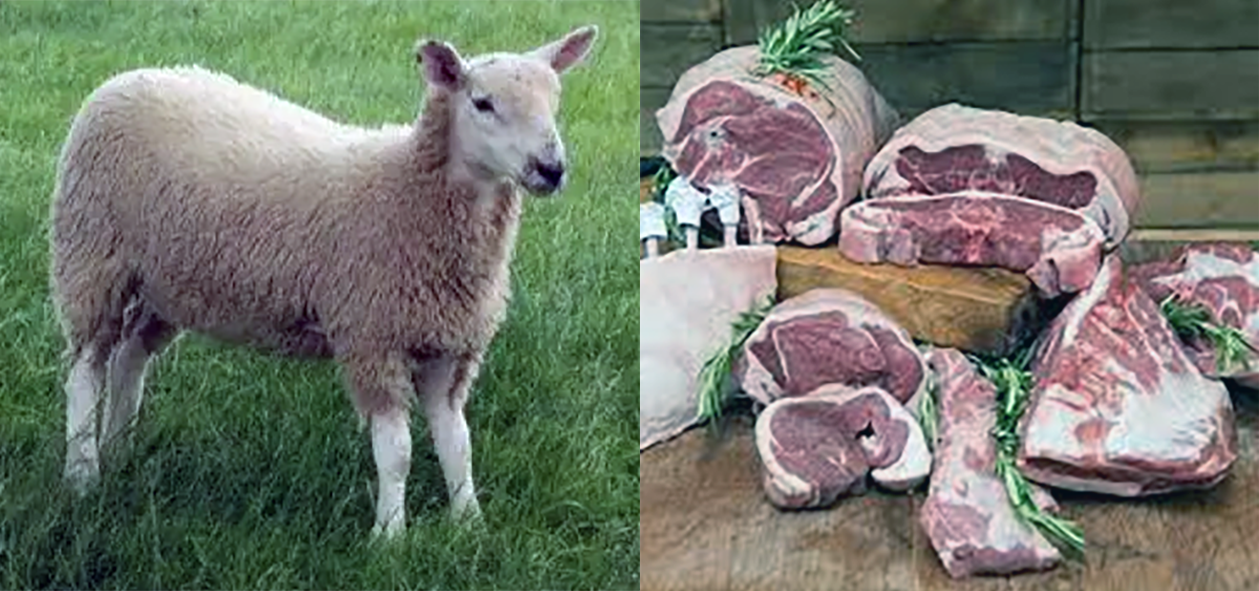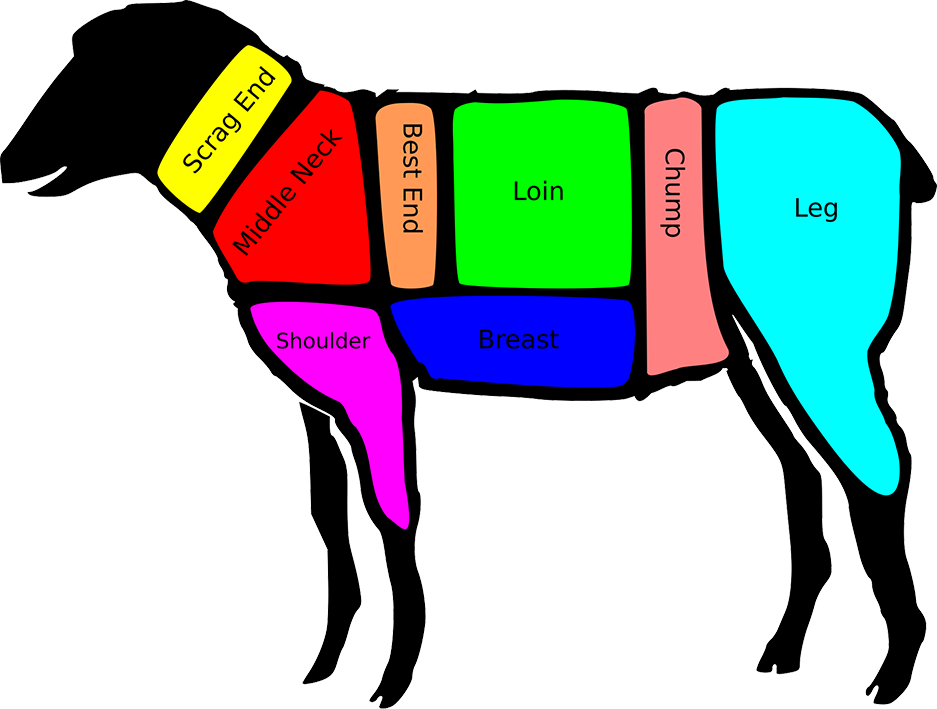FabulousFusionFood's Lamb-based Recipes 5th Page
 Mature lamb and a selection of lamb cuts.
Mature lamb and a selection of lamb cuts.
Welcome to FabulousFusionFood's Lamb-based Recipes Page — The recipes presented here are all based on cow meat. Lamb represents a young sheep (Ovis aries) which is less than one year old.
Hogget is term for a sheep of either sex having no more than two permanent incisors in wear, or its meat. In the UK, it means animals that are 11 to 24 months old. Still common in farming usage and among speciality butchers, it is now a rare term in British, Australian and New Zealand supermarkets, where meat of all sheep less than two years old tends to be called 'lamb'.
Other types of lamb are as follows:
Suckling lamb or milk-fed lamb — meat from an unweaned lamb, typically 4–6 weeks old and weighing 5.5–8 kg. This is typically generally unavailable in the UK but can be sourced from speciality butchers and farm shops.
Young lamb — a milk-fed lamb between six and eight weeks old
Spring lamb — a lamb, usually three to five months old, born in late winter or early spring and sold usually before 1 July (in the northern hemisphere).
Yearling lamb — a young sheep between 12 and 24 months old
Salt marsh lamb (also known as 'saltmarsh lamb' or by its French name, agneau de pré-salé) is the meat of sheep which graze on salt marsh in coastal estuaries that are washed by the tides and support a range of salt-tolerant grasses and herbs, such as samphire, sparta grass, sorrel and sea lavender.
The meat of a lamb is taken from the animal between one month and one year old, with a carcass weight of between 5.5 and 30 kg (12 and 66 lb). This meat generally is more tender than that from older sheep and appears more often on tables in some Western countries.
Sheep are most likely descended from the wild mouflon of Europe and Asia, with Iran being a geographic envelope of the domestication centre. One of the earliest animals to be domesticated for agricultural purposes, sheep are raised for fleeces, meat (lamb, hogget or mutton), and milk. A sheep's wool is the most widely used animal fibre, and is usually harvested by shearing. In Commonwealth countries, ovine meat is called lamb when from younger animals and mutton when from older ones; in the United States, meat from both older and younger animals is usually called lamb. Sheep continue to be important for wool and meat today, and are also occasionally raised for pelts, as dairy animals, or as model organisms for science.
Sheep meat and milk were one of the earliest staple proteins consumed by human civilization after the transition from hunting and gathering to agriculture. Sheep meat prepared for food is known as either mutton or lamb, and approximately 540 million sheep are slaughtered each year for meat worldwide. "Mutton" is derived from the Old French moton, which was the word for sheep used by the Anglo-Norman rulers of much of the British Isles in the Middle Ages. This became the name for sheep meat in English, while the Old English word sceap was kept for the live animal. Throughout modern history, "mutton" has been limited to the meat of mature sheep usually at least two years of age; "lamb" is used for that of immature sheep less than a year.
Cuts of Lamb (UK, Canada, and other Commonwealth countries):
 Cuts of Lamb:
Cuts of Lamb:Scrag end (of neck) — stewing
Middle neck — braising, stewing
Best End (of neck) — roasting, stewing, braising
Loin (including chops, racks and saddle) — roasting, frying, braising
Chump (and chump chops) — frying
Barnsley chop, a large double loin chop — frying
Leg (gigot in Scotland) including leg steaks — roasting, frying
Shank — braising
Shoulder — roasting Breast — braising
Offal — typically tongue, liver, heart, stomach, sweetbreads, testicles, intestines and kidneys
The alphabetical list of all the lamb-based recipes on this site follows, (limited to 100 recipes per page). There are 507 recipes in total:
Page 5 of 6
| Saltah Origin: Yemen | Soganli Yahni (Mutton Stew with Onions) Origin: Turkey | Tanzanian Meat Stew Origin: Tanzania |
| Samarkandskij Jagnenok (Samarkand Lamb) Origin: Uzbekistan | Somali-style Liver Origin: Somaliland | Tarten Oen a Bricyll gyda Crwst Persli (Lamb and Apricot Pie with Parsley Crust) Origin: Welsh |
| Saniyit Kufta (Baked Beef Patties) Origin: Egypt | Somali-style Liver Origin: Somalia | Tarten Sibolau a Bacwn (Shepherd's Pie with Cheese-crusted Leek Topping) Origin: Welsh |
| Sarson Saag Gosht (Lamb and Rapeseed Greens Curry with Yoghurt) Origin: India | Sorrel Sarma Origin: North Macedonia | Tas-Kebab (Lamb Cooked in Wine) Origin: Bulgaria |
| Satan's Fantasy Chili Origin: American | Soupe aux pois et la viande (Pea Soup and Meat) Origin: Guinea-Bissau | Tasqebap (Fried Lamb with Tomatoes) Origin: Albania |
| Sauce Gbanbouda (Tô with Okra Sauce and Peanuts) Origin: Guinea | Soupe d'Illane (Ilan Soup) Origin: Morocco | Tass Kebab (Fried Lamb in Tomato Sauce) Origin: Armenia |
| Sauce Koumrangan (Hibiscus Leaf Sauce) Origin: Chad | South African Cape Malay Curry Origin: South Africa | Tatws â Chig yn y Popty (Meat and Potatoes in the Oven) Origin: Welsh |
| Scotch Broth Origin: Scotland | South African Curried Leg of Lamb Origin: India | Tatws a Chig Mewn Popty Araf (Potatoes and Meat in the Slow Cooker) Origin: Welsh |
| Scotch Broth with Pepper Dulse Origin: Scotland | South African Lamb Curry Origin: South Africa | Tavë Kosi (Baked Lamb and Yoghurt) Origin: Albania |
| Shaiyah (Pan-fried Meat) Origin: South Sudan | South African Lamb Pilaff Origin: South Africa | Tavë Kosi (Baked Lamb and Yoghurt) Origin: Kosovo |
| Shakshouka 2 (Chilli, Egg and Tomato Breakfast) Origin: Yemen | Souvlaki Origin: Greece | Tave Elbanasi (Boiled Lamb with Yoghurt) Origin: Albania |
| Shami Kebab Origin: India | Spicy Lamb Burgers Origin: Britain | Tave Kosi 2 (Baked Lamb with Yoghurt) Origin: Albania |
| Sharba Ramadan (Ramadan Soup) Origin: Libya | Spicy Lamb Kebabs Origin: Britain | Teisen Nionod â Chig Oen (Welsh Onion Cake with Lamb) Origin: Welsh |
| Sharbat Libya (Libyan Soup) Origin: Libya | St Helena Curry and Rice Origin: St Helena | Terîn Cig Oen (Welsh Lamb Terrine) Origin: Welsh |
| Shashlyk Origin: Azerbaijan | St Lucian Pepper Pot Origin: Saint Lucia | Thyme-scented Lamb with Almond Skordalia Origin: Australia |
| Shawarma-style pulled lamb with tahini-yogurt dressing Origin: Fusion | Steak and Kidney Kebabs Origin: Britain | Tishreeb Hummus (Chickpea Casserole) Origin: Iraq |
| Sheikh Kebab Origin: India | Stecen Cig Oen Gyda Rhosmari a Cwrens Cochion (Lamb Steak with Rosemary and Red Currants) Origin: Welsh | To Dress a Hen, Mutton or Lamb the Indian Way Origin: England |
| Shepherd's Pie Origin: Britain | Sticky Lamb Ribs Origin: Britain | Toad-in-the-Hole Origin: British |
| Shifa (Lebanese Lamb and Pine Nut Pizza) Origin: Lebanon | Stiw Cig Oen Cymreig (Welsh Lamb Stew) Origin: Welsh | Tolma (Cabbage Stuffed with Lamb) Origin: Georgia |
| Shisa Nyama Origin: South Africa | Stovies Origin: Scotland | Torten Oen a Thatws (Welsh Lamb and Potato Torte) Origin: Welsh |
| Shisa Nyama Origin: eSwatini | Suaasat Origin: Greenland | Traditional Historic Bobotie Origin: South Africa |
| Shish Kebabs Origin: Britain | Sugar Bean Curry Origin: South Africa | Tsebhi Sega (Spicy Minced Meat) Origin: Eritrea |
| Shorba Origin: Sudan-a | Summer Lamb Casserole Origin: Britain | Tuh'u (Mesopotamian Lamb and Beetroot Stew) Origin: Mesopotamia |
| Shurpa Origin: Uzbekistan | Super-speedy Microwave Lamb Curry Origin: Britain | Tunisian Spiced Lamb Balls Origin: Tunisia |
| Shuwa (Slow-cooked Spicy Lamb) Origin: Oman | Şurpa (Shurpa) Origin: Turkmenistan | Valentine Lamb Steaks with Avocado and Sour Cream Origin: American |
| Sindhi-style Pilau Origin: Pakistan | Suya Curry Origin: Fusion | Viande Nyembwe (Meat Nyembwe) Origin: Gabon |
| Sis Kebap (Turkish Shish Kebab) Origin: Turkey | Sweet Lamb Fillet Origin: British | West African Roast Lamb Origin: West Africa |
| Skoudehkaris (Djibouti Rice) Origin: Djibouti | Tabah Moostafah (Tagine of Marrakech Lamb) Origin: Morocco | Wonchoi Origin: Ghana |
| Slow Cooker Lamb Rogan Josh Origin: Britain | Tagine bal Ghalmi wa Aflour (Lamb Tagine with Broad Beans) Origin: Morocco | Xinjiang Lamb Casserole Origin: China |
| Slow-cooked Lamb Curry Origin: Britain | Tagine bal Ghalmi wa Gharraa wa Na'Na' (Lamb Tagine with Courgette and Mint) Origin: Morocco | Xinjiang Lamb Skewers Origin: Fusion |
| Slow-cooked Lamb Madras Origin: Britain | Tagine bel Ghamli wal Barkouk wa Geijlane (Lamb Tagine with Prunes and Sesame Seeds) Origin: Morocco | Yarpakh Dolmasy (Vine Leaves Stuffed with Lamb and Rice) Origin: Azerbaijan |
| Slow-cooked Moorish Lamb with Buttermilk Dressing Origin: Fusion | Tagine Lahm bil Beleh (Lamb Tagine with Dates) Origin: Morocco | Yoghurt Lamb Steaks with Minted Yoghurt Origin: Britain |
| Slow-roast Lamb Shoulder with Honey, Herbs and Harissa Origin: Britain | Tagine of Lamb with Pumpkin Origin: North Africa | |
| Slow-roasted Lamb Shanks with Tomatoes and Olives Origin: Australia | Tandoori Lamb Chops Origin: Britain |
Page 5 of 6